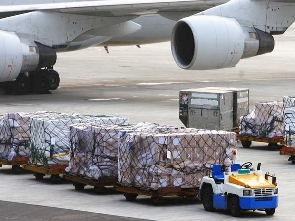Cargo, one of the least glamorous aspects of flying, is proving a rare ray of light for airlines amid the coronavirus gloom.
The grounding of passenger planes at a time of increased demand for everything from medical supplies to iPhones has boosted freight rates. With much of the world’s population house-bound and shopping online instead of hitting the malls, analysts see no let up in demand, particularly as the peak year-end holiday season approaches.
“Airfreight is going to be a bright spot for carriers at least for this year because while borders are closed that doesn’t mean people aren’t buying,” said Um Kyung-a, an airline analyst at Shinyoung Securities Co. in Seoul. “That trend is likely to continue as cargo capacity remains limited.”
The sort of goods moving along this global conveyor belt 30,000 feet in the sky also track the pandemic’s unfurling. Masks and gloves have given way to semiconductor chips and PC parts as consumers set up work-from-home arrangements. Fresh produce is also big as people venture out less. Ultimately, once a vaccine is found, airlines will be used to disperse billions of vials quickly and in a temperature-controlled environment.
Under normal circumstances, about 60% of air cargo globally is flown in the belly hold of passenger flights. With hundreds of those jets parked in deserts waiting out the pandemic, airfreight costs have spiraled: rates to North America from Hong Kong are up almost 60% this year.
For Qantas Airways Ltd., medical freight out of China hit a peak in May and June.
“What we saw were huge uplifts of light but very bulky freight — masks and gowns and gloves and the like. That was when we started to see airlines put light, fluffy boxes into passenger cabins,” said Nick McGlynn, who oversees Qantas’s freight sales and network as the unit’s chief customer officer.
That’s now subsided and Qantas has since been flying fresh produce from Australia into Asia including “significant amounts” of tuna to Japan and coral trout to Hong Kong, he said.
On routes back to Australia, it’s dominated by medical supplies, car parts and electronics, as well as components for Caterpillar Inc. mining equipment from the U.S.
Fiji Airways is making a little extra from carrying seafood and kava, CEO Andre Viljoen said during a presentation last week.
Bloomberg Intelligence predicts belly capacity from passenger air fleets won’t return to pre-pandemic levels before 2022. Not every airline is able to pivot to address the changed circumstances. But those that can haven’t wasted any time.
In the U.S., United Airlines Holdings Inc. recently operated its 5,000th cargo-only flight (the busiest air cargo routes are between Asia and North America.) The carrier’s revenue from cargo jumped more than 36% in the second quarter to $402 million.
American Airlines Group Inc., meanwhile, has relaunched cargo-only services after a 35-year hiatus. In September, it expects to operate more than 1,000 cargo-only wide-body flights, primarily Boeing Co. 777s and 787s, to 32 destinations in Latin America, Europe and Asia.
In Asia, Singapore Airlines Ltd.’s budget long-haul arm Scoot last month removed the passenger seats from one of its Airbus SE A320s to free up more space, while Korean Air Lines Co., which is also converting planes, and Asiana Airlines Inc. eked out quarterly profits after flying jets loaded with technology components to sate consumer demand for at-home gadgets.
With the exception of cargo, global airline share prices have barely risen from the low reached in March, while overall equity markets have recently recovered to pre-COVID-19 levels.
Emirates, the world’s fourth-biggest cargo carrier after Federal Express Corp., Qatar Airways and United Parcel Service Inc., said it “reacted very quickly,” scaling up its cargo network to around 50 destinations by early April, 75 by mid-May and 100 by the start of July.
“We’ve been able to connect more than 115 destinations with cargo capacity on a scheduled basis,” said Emirates’ Divisional Senior Vice President of Cargo, Nabil Sultan. “We worked round the clock to use not only our freighter fleet, but also our passenger aircraft for cargo flights.”
That’s not to say there isn’t an enormous amount of pain in global aviation. Airlines are hemorrhaging cash and laying off tens of thousands of staff.
While the cargo operations of Deutsche Lufthansa AG contributed a record 299 million euros ($354 million) to the group’s operating profit in the second quarter, and the operating margin of the airline’s cargo arm was a robust 39%, the wider Lufthansa group suffered a massive 1.7 billion euro operating loss in the three-month period.
Still, in such a tough environment, every bit counts. Indonesia’s PT Lion Mentari Airlines is even hauling basic necessities like non-perishable food stuffs by plane across its vast archipelago.
“Canned foods, things you’d normally buy on your grocery trip, are being air flown because this is a more efficient way to have them delivered across the country,” Managing Director Daniel Putut said. “With passengers falling sharply, we have to find other revenue means.”
Qatar Airways, one of the world’s heavyweights in freight, doesn’t see cargo rates coming down for at least 12 months.
“The world is a village and air cargo is the main street,” said Guillaume Halleux, Qatar’s chief cargo officer. “Airlines in general have become the lifeline for the world, and airlines with strong strategies and agility have been able to sustain themselves most easily.”
Business News of Monday, 7 September 2020
Source: thebusiness24online.net
Coronavirus: Airlines are removing seats to make space for gadgets and seafood cargoes
Entertainment












